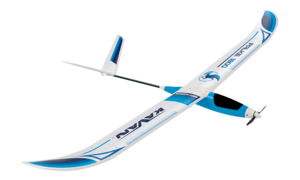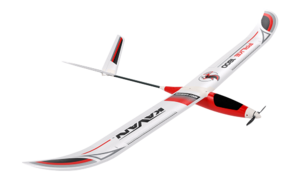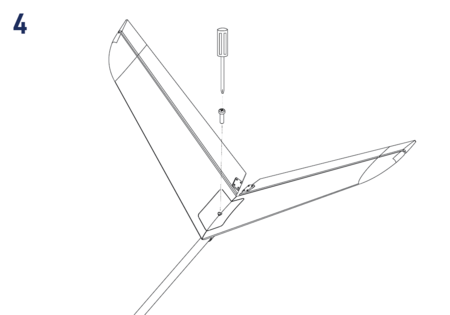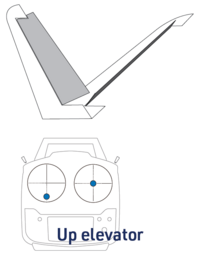KAVAN Falke 1800mm ARF - Bauanleitung
Einführung
Herzlichen Glückwunsch zum Kauf des leistungsstarken Motorseglers FALKE 1800. Sie sind die Besitzer eines nahezu unzerbrechlichen Schaumstoffmodells aus EPO (extrudiertes Polyolefin) geworden, das mit einem leistungsstarken Brushless-Motor angetrieben wird, der von LiPo-Akkus versorgt wird. Jeder, wer es bereits schafft, mit einem Modell mit Querrudern zu fliegen, genießt hundertprozentig das Steuern dieses edlen leistungsstarken Thermik-Seglers!
Bevor Sie beginnen
- Falls Sie kein erfahrener Pilot sind, nehmen Sie die Hilfe eines kompetenten Piloten in Anspruch um ihr zusammengebautes Modell zu überprüfen und bei den Erststarts zu helfen. Obwohl wir Ihnen eine vollständige Anleitung zur Verfügung gestellt haben, so ist ein Modellflugzeug ziemlich kompliziert und ein erfahrener Modellbauer kann schnell ihr Modell überprüfen und somit sicherstellen, dass ihre ersten Flüge erfolgreich werden.
- Bitte bauen Sie ihr Modell genau nach dieser Anleitung auf. Versuchen Sie nicht ihren FOX zu modifizieren oder zu verändern, da dies die Flugeigenschaften negativ beeinflussen kann.
- Bevor Sie beginnen prüfen Sie den Inhalt des Bausatzes auf Vollständigkeit und prüfen Sie, dass keine Teile beschädigt sind. Dies hilft auch sich mit den Teilen des Modells vertraut zu machen. Falls Teile fehlen oder beschädigt sind, so wenden Sie sich umgehend an ihren Händler.
- Versuchen Sie zuerst die Teile zusammenzufügen bevor Sie sie verkleben. Versichern Sie sich, dass sie die korrekten Teile benutzen und dass sie gut zusammen passen vor dem Zusammenbau. Auch viel Kleber kann schlecht passende Teile nicht zurecht machen.
- Die Anleitung zeigt die Standart Einstellung des Schwerpunktes. (CG) und empfohlene Ruderausschläge. Bitte berücksichtigen Sie, dass es wesentlich ist den empfohlenen Schwerpunkt beizubehalten für die ersten Flüge, ansonsten könnte das Modell unstabil und schwer zu fliegen sein, oder gar nicht fliegen. Sie können den Schwerpunkt später tunen um ihn an ihren Flugstil und ihr Können anzupassen.
Vorsichtsmaßnahmen
Dieses RC-Modell ist kein Spielzeug. Benutzen Sie es mit Vorsicht und befolgen Sie die Anweisungen in dieser Anleitung genau.
Sie sich an die Anweisungen in dieser Anleitung. Bauen Sie das Modell gemäß der Anleitung zusammen. Modifizieren und verändern Sie das Modell nicht. Bei Nichteinhaltung erlischt die Garantie. Folgen Sie der Anleitung um ein sicheres und haltbares Modell nach dem Zusammenbau zu erhalten.
Kinder unter 14 Jahren müssen das Modell unter Aufsicht eines Erwachsenen betreiben.
Versichern Sie sich vor jedem Flug, dass das Modell in einwandfreiem Zustand ist, dass alles einwandfrei funktioniert und das Modell unbeschädigt ist.
Fliegen Sie nur an Tagen mit leichtem Wind und an einem sicheren Platz ohne Hindernisse.
Sicherheitsmaßnahmen und Warnungen
- Ein ferngesteuertes Modell ist kein Spielzeug! Es kann erhebliche Verletzungen und Sachbeschädigungen anrichten. Fliegen Sie nur an einem sicheren Ort und folgen Sie den Anweisungen und Empfehlungen dieser Anleitung. Bleiben Sie von der Luftschraube weg! Halten Sie lose Teile entfernt von der drehenden Luftschraube, damit sie nicht eingesaugt werden können. Dies schließt lose Kleidung, und andere Sachen wie Kugelschreiber und Schraubendreher mit ein. Gehen Sie sicher, dass ihre und andere Leute Hände und Gesicht vom drehenden Propeller weg sind.
- Als Betreiber des Modells sind Sie alleine verantwortlich für die sichere Anwendung, dass weder Sie noch andere verletzt werden, oder das Modell beschädigt wird, oder Schäden an anderen Sachen entstehen. Dieses Modell wird durch eine Funk-Fernsteuerung gelenkt deren Signal durch viele Dinge gestört werden können, die außerhalb Ihrer Kontrolle sind. Diese Störungen können vorübergehenden Verlust der Steuerbarkeit zur Folge haben und es ist deshalb ratsam eine sichere Entfernung in allen Richtungen um ihr Modell herum zu haben um Kollisionen und Verletzungen zu vermeiden.
- Betreiben Sie ihr Modell nie mit schwachen Senderbatterien.
- Betreiben Sie ihr Modell immer im offenen Gelände entfernt von Stromleitungen, Autos, Verkehr, Menschen. Betreiben Sie ihr Modell nie in bewohnten Gebieten.
- Beachten Sie exakt diese Anweisungen und Warnungen. Dies gilt auch für die zusätzliche Ausrüstung, die Sie einsetzen. (Ladegeräte, wieder aufladbare Akkus, usw.)
- Halten Sie alle Chemikalien, Kleinteile und jegliche elektrischen Teile außerhalb der Reichweite von Kindern.
- Feuchtigkeit verursacht Beschädigungen der Elektronik. Vermeiden Sie Wasser-Kontakt aller Teile, die nicht dafür ausgelegt oder dagegen geschützt sind.
- Das Modell ist mehrheitlich aus Kunststoff hergestellt. Es ist nicht feuerfest. Es darf nicht höheren Temperaturen ausgesetzt werden, ansonsten könnten Verformungen oder andere Beschädigungen auftreten.
Technische daten
| Spannweite | 1800 mm |
| Länge | 1150 mm |
| Flügelfläche | 27 dm² |
| Fluggewicht | 660–710 g |
| Elektromotor | C2714–1450 |
| Regler | KAVAN R–20B BEC |
| Luftschraube | 7×6" |
Set inhalt
• ARTF Modell eines Seglers mit Brushless Motor, Empfänger, Regler und Servos installiert, Anleitung.
Sie brauchen zusätzlich
- At least 4-channel RC set featuring V-tail mix, 11.1 V 1200–1600 mAh LiPo flight pack.
- Regular modeller’s tools - modeller’s knife, screwdrivers, 1.5 and 2 mm Allen key, pliers etc.
Model assembly
- Locate the steel wire wing joiner (note the "V" shape ensuring the correct wing dihedral) and slide both wing halves onto the joiner. (Fig. 1)
- Connect the aileron servo cables to the corresponding extension cables in the wing opening in the fuselage. (Fig. 2)Note: The kit is supplied with a Y-cable for ailerons so you can use even the most basic 4-channel radios to control your FALKE 1800. If you intend to use independent control of aileron servos and an advanced computer radio, you will have to replace the default Y-cable with two 25–30 cm extension cables.
- Attach the plastic wing joiner and secure the wing to the fuselage with two M5×20 mm nylon bolts. (Fig. 3)
- Attach the V-tail planes to the tailplane seat and secure them with the plastic joiner and M3 hex screw to the fuselage. (Fig. 4)
- Connect the plastic quick links to the ruddervator horns. (Fig. 5)
- The flight pack is to be placed in the bay in the centre of the cockpit; use a Hook-and-loop tie to fasten it. You can place your receiver (secured with a strip of Hook-and-loop or double-sided foam tape) behind the flight pack. Connect servos and your ESC to the receiver; deploy the antennas so their active parts are square to each other (if you are using a receiver featuring diversity antennas). With your radio on, set the servos to the neutral position (sticks and trims centred) - screw in or out the quick links as needed. Perform the throttle range calibration of the ESC as described in the attachment of this manual. (Fig. 6)
- Attach the canopy.
RC set installation and preflight check
- Referring to the instruction manual of your radio carefully hook up the onboard electronics.
- Once everything has been correctly connected, turn on your transmitter and plug in the flight pack. Check the neutral positions and throws of all control surfaces - double-check the correct set-up of the V-tail mix. If you need to make the control surface throws smaller, simply move the pushrod closer to the centre on the servo arm or move it far from the control surface on the control horn. And vice versa.
| Low rate | High rate | |
| Ailerons | 10 mm up/5 mm down 1 | 13 mm up/ 7 mm down |
| Ailerons (Airbrake) | 10 mm up | 10 mm up |
| Elevator | ± 7 mm | ± 10 mm |
| Elevator (Airbrake) | 2 mm up | 2 mm up |
| Rudder | ± 10 mm | ± 13 mm |
- The "Low rate" recommended control surface throws are suitable for a less skilled pilot and regular soaring. The "High rate" setting allows an experienced pilot to explore the full capabilities of his model. The aileron differential (aileron down deflection reduced to 50 % of up deflection) is only possible with a computer radio.
- Check the direction of rotation of the propeller. If it was incorrect, simply swap two of the three wires between the ESC and motor or program the ESC (refer to the ESC manual).
- Check the correct position of the centre of gravity (CG) – 56–63 mm behind the leading edge of the wing (Fig. 7). Adjust the CG position by moving the flight pack - if you could not reach the recommended position, do not hesitate to add an appropriate amount of lead to the nose or tail. An extra couple of grams won’t spoil the flying characteristics - but the incorrect CG position is a killer.
- Fully charge your flight pack and transmitter batteries, check the proper function of your radio and perform the range check of your radio according to its instruction manual. The range has to be almost the same with the motor off and at full throttle (no more than a 10 % decrease is acceptable). DO NOT try to fly unless the range check is 100 % successful.
Flying
The test flying and fine-tuning is pretty much straightforward, there will be no surprise for a medium-advanced pilot that is supposed to fly this model.
Recycling and waste disposal note (European Union)

Electrical equipment marked with the crossed-out waste bin symbol must not be discarded in the domestic waste; it should be disposed of via the appropriate specialised disposal system. In the countries of the EU (European Union) electrical devices must not be discarded via the normal domestic waste system (WEEE - Waste of Electrical and Electronic Equipment, Directive 2012/19/EU). You can take your unwanted equipment to your nearest public collection point or recycling centre, where it will be disposed of in the proper manner at no charge to you. By disposing of your old equipment in a responsible manner you make an important contribution to the safeguarding of the environment!
EU declaration of conformity (European Union)

Hereby, KAVAN Europe s.r.o. declares that the model FALKE and the included electronic and electric devices are in compliance with the requirements of relevant European directives and harmonized norms. The full text of the Declaration of Conformity is available at www.kavanrc.com/doc/.
Guarantee
The KAVAN Europe s.r.o. products are covered by a guarantee that fulfils the currently valid legal requirements in your country. If you wish to make a claim under guarantee, please contact the retailer from whom you first purchased the equipment. The guarantee does not cover faults which were caused in the following ways: crashes, improper use, incorrect connection, reversed polarity, maintenance work carried out late, incorrectly or not at all, or by unauthorised personnel, use of other than genuine KAVAN Europe s.r.o. accessories, modifications or repairs which were not carried out by KAVAN Europe s.r.o. or an authorised KAVAN Europe s.r.o., accidental or deliberate damage, defects caused by normal wear and tear, operation outside the Specification, or in conjunction with equipment made by other manufacturers. Please be sure to read the appropriate information sheets in the product documentation!












